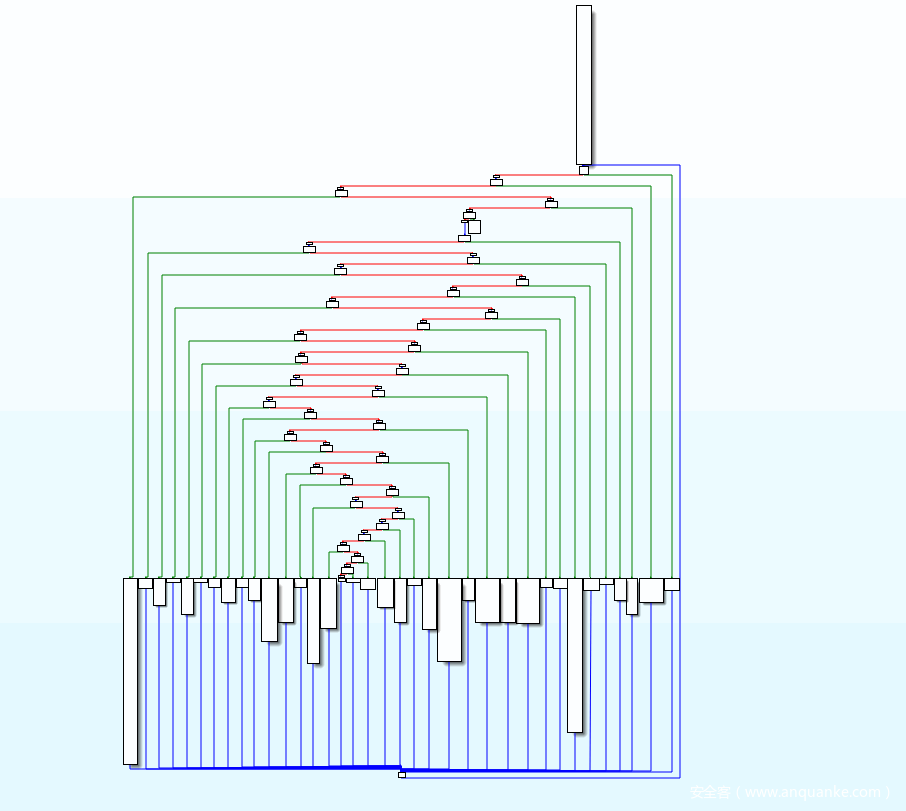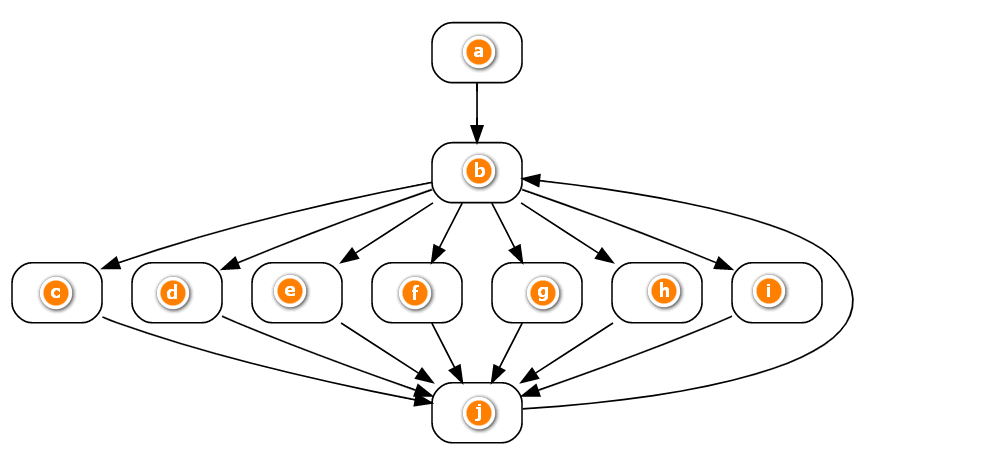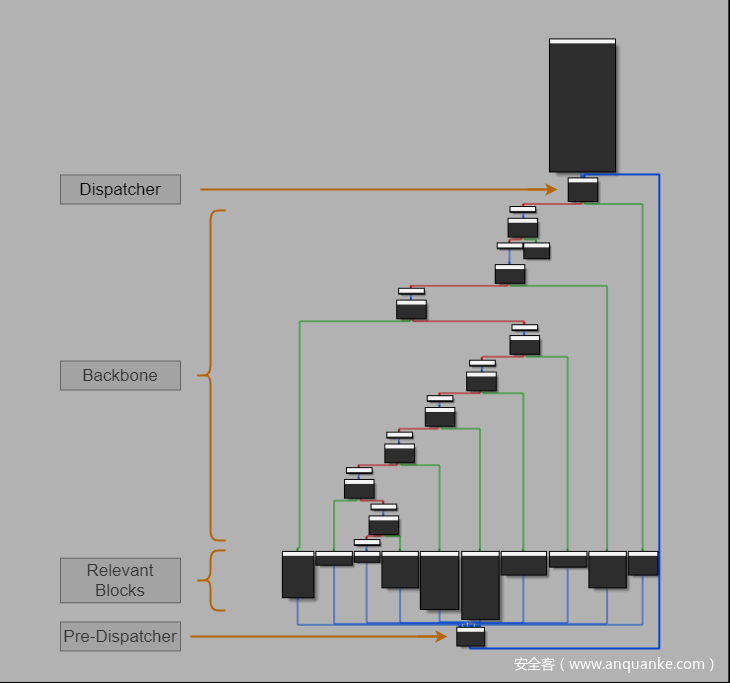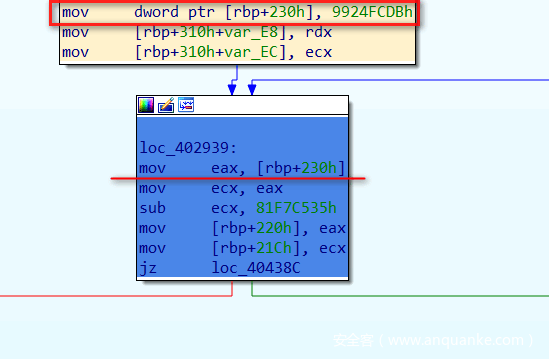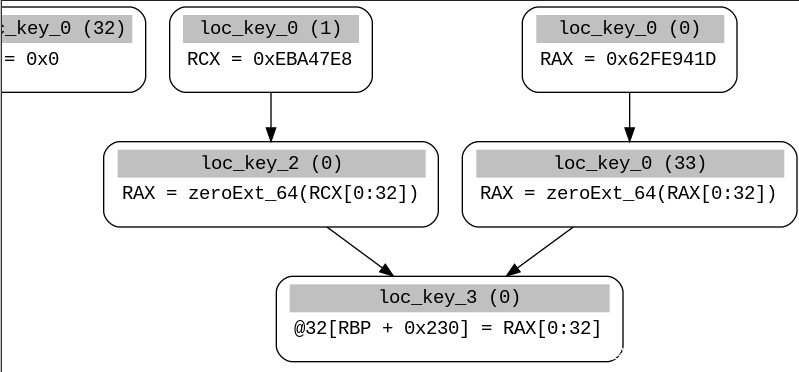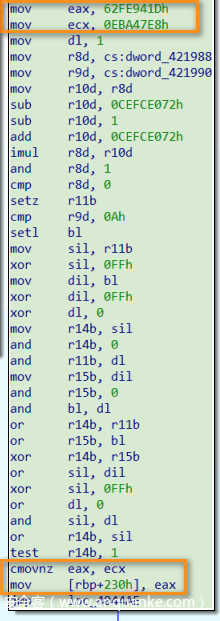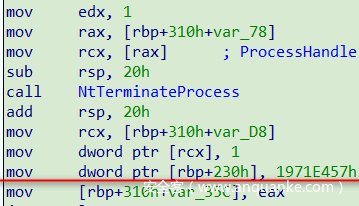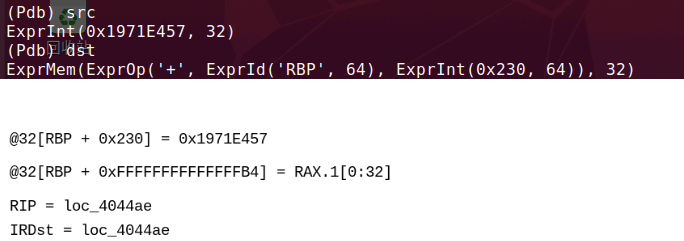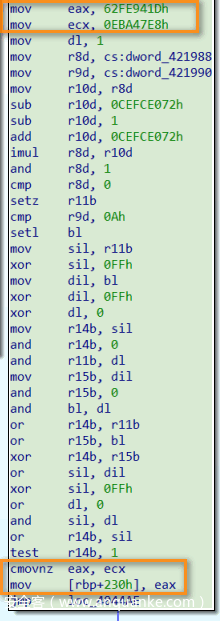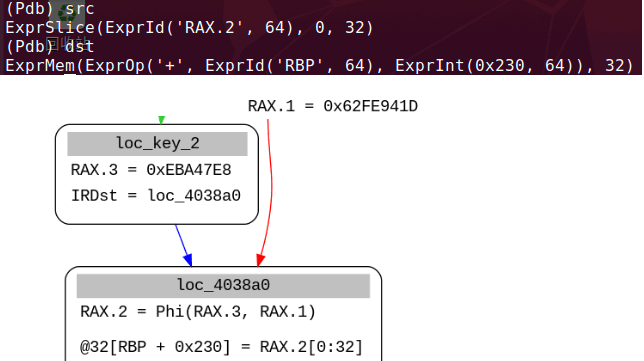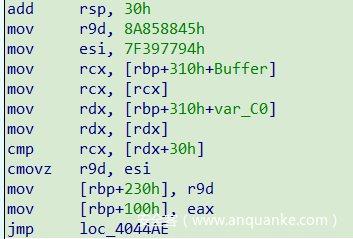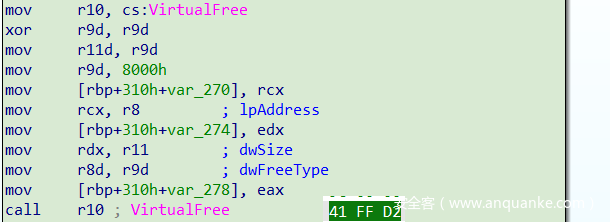0x00 前言
笔者于五月份时遇到几个经控制流平坦化的样本,由于之前没有接触过这方面知识,未深入分析。
七月初看到一篇博客——MODeflattener – Miasm’s OLLVM Deflattener,作者同时在Github上公开其源码,故笔者决定对其一探究竟。该工具使用miasm框架,Quarklab于2014年的博客——Deobfuscation: recovering an OLLVM-protected program中已提到此框架,但其采用符号执行以遍历代码,计算每个Relevant Block目标终点,恢复执行流程。腾讯SRC于2017年的博客——利用符号执行去除控制流平坦化中亦是采用符号执行(基于angr框架),而MODeflattener采用静态分析方式来恢复执行流程。笔者于下文首先结合具体样本分析其源码及各函数功能,之后指出该工具不足之处并提出改进方案。关于涉及到的miasm框架中类,函数,属性及方法可参阅miasm Documentation与miasm源码。LLVM,OLLVM,LLVM Pass及控制流平坦化不再赘述,具体可参阅基于LLVM Pass实现控制流平坦化与OLLVM Flattening源码。
0x01 源码分析
0x01.1 检测平坦化
def calc_flattening_score(asm_graph):
score = 0.0
for head in asm_graph.heads_iter():
dominator_tree = asm_graph.compute_dominator_tree(head)
for block in asm_graph.blocks:
block_key = asm_graph.loc_db.get_offset_location(block.lines[0].offset)
dominated = set(
[block_key] + [b for b in dominator_tree.walk_depth_first_forward(block_key)])
if not any([b in dominated for b in asm_graph.predecessors(block_key)]):
continue
score = max(score, len(dominated)/len(asm_graph.nodes()))
return score
计算每个块支配块数量,除以图中所有块,取最高分——若不低于0.9,证明该函数经过控制流平坦化。如下图:
块b支配除块a外其余所有块(包含自身),那么其得分为9/10=0.9即最高分。读者可自行查阅Dominator Tree及Predecessors相关数据结构知识,此外不作展开。
0x01.2 获取平坦化相关信息
def get_cff_info(asmcfg):
preds = {}
for blk in asmcfg.blocks:
offset = asmcfg.loc_db.get_location_offset(blk.loc_key)
preds[offset] = asmcfg.predecessors(blk.loc_key)
# pre-dispatcher is the one with max predecessors
pre_dispatcher = sorted(preds, key=lambda key: len(preds[key]), reverse=True)[0]
# dispatcher is the one which suceeds pre-dispatcher
dispatcher = asmcfg.successors(asmcfg.loc_db.get_offset_location(pre_dispatcher))[0]
dispatcher = asmcfg.loc_db.get_location_offset(dispatcher)
# relevant blocks are those which preceed the pre-dispatcher
relevant_blocks = []
for loc in preds[pre_dispatcher]:
offset = asmcfg.loc_db.get_location_offset(loc)
relevant_blocks.append(get_block_father(asmcfg, offset))
return relevant_blocks, dispatcher, pre_dispatcher
首先拥有最大数量Predecessor者即为Pre-Dispatcher,而Pre-Dispatcher后继为Dispatcher,Pre-Dispatcher所有前趋均为Relevant Block。
dispatcher_blk = main_asmcfg.getby_offset(dispatcher)
dispatcher_first_instr = dispatcher_blk.lines[0]
state_var = dispatcher_first_instr.get_args_expr()[1]
Dispatcher块第一条指令为状态变量:
0x01.3 去平坦化
for addr in relevant_blocks:
_log.debug("Getting info for relevant block @ %#x"%addr)
loc_db = LocationDB()
mdis = machine.dis_engine(cont.bin_stream, loc_db=loc_db)
mdis.dis_block_callback = stop_on_jmp
asmcfg = mdis.dis_multiblock(addr)
lifter = machine.lifter_model_call(loc_db)
ircfg = lifter.new_ircfg_from_asmcfg(asmcfg)
ircfg_simplifier = IRCFGSimplifierCommon(lifter)
ircfg_simplifier.simplify(ircfg, addr)
遍历每个Relevant Block,为其创建ASM CFG及IR CFG,作者实现了一save_cfg函数可将CFG输出(需要安装Graphviz):
def save_cfg(cfg, name):
import subprocess
open(name, 'w').write(cfg.dot())
subprocess.call(["dot", "-Tpng", name, "-o", name.split('.')[0]+'.png'])
subprocess.call(["rm", name])
之后查找所有使用状态变量及定义状态变量语句:
nop_addrs = find_state_var_usedefs(ircfg, state_var)
...
def find_state_var_usedefs(ircfg, search_var):
var_addrs = set()
reachings = ReachingDefinitions(ircfg)
digraph = DiGraphDefUse(reachings)
# the state var always a leaf
for leaf in digraph.leaves():
if leaf.var == search_var:
for x in (digraph.reachable_parents(leaf)):
var_addrs.add(ircfg.get_block(x.label)[x.index].instr.offset)
return var_addrs
可以看到DefUse图与语句对应关系:
查找状态变量所有可能值:
def find_var_asg(ircfg, var):
val_list = []
res = {}
for lbl, irblock in viewitems(ircfg.blocks):
for assignblk in irblock:
result = set(assignblk).intersection(var)
if not result:
continue
else:
dst, src = assignblk.items()[0]
if isinstance(src, ExprInt):
res['next'] = int(src)
val_list += [int(src)]
elif isinstance(src, ExprSlice):
phi_vals = get_phi_vars(ircfg)
res['true_next'] = phi_vals[0]
res['false_next'] = phi_vals[1]
val_list += phi_vals
return res, val_list
为状态变量赋值有两种情况——一种是直接赋值,不涉及条件判断及分支跳转,其对应ExprInt:
另一种是CMOV条件赋值,其对应ExprSlice:
之后计算每一状态变量可能值对应Relevant Block:
# get the value for reaching a particular relevant block
for lbl, irblock in viewitems(main_ircfg.blocks):
for assignblk in irblock:
asg_items = assignblk.items()
if asg_items: # do not enter if nop
dst, src = asg_items[0]
if isinstance(src, ExprOp):
if src.op == 'FLAG_EQ_CMP':
arg = src.args[1]
if isinstance(arg, ExprInt):
if int(arg) in val_list:
cmp_val = int(arg)
var, locs = irblock[-1].items()[0]
true_dst = main_ircfg.loc_db.get_location_offset(locs.src1.loc_key)
backbone[hex(cmp_val)] = hex(true_dst)
如下图:
将fixed_cfg中存储的状态变量值替换为目标Relevant Block地址:
for offset, link in fixed_cfg.items():
if 'cond' in link:
tval = fixed_cfg[offset]['true_next']
fval = fixed_cfg[offset]['false_next']
fixed_cfg[offset]['true_next'] = backbone[tval]
fixed_cfg[offset]['false_next'] = backbone[fval]
elif 'next' in link:
fixed_cfg[offset]['next'] = backbone[link['next']]
else:
# the tail doesn't has any condition
tail = int(offset, 16)
将所有无关指令替换为NOP:
for addr in rel_blk_info.keys():
_log.info('=> cleaning relevant block @ %#x' % addr)
asmcfg, nop_addrs = rel_blk_info[addr]
link = fixed_cfg[hex(addr)]
instrs = [instr for blk in asmcfg.blocks for instr in blk.lines]
last_instr = instrs[-1]
end_addr = last_instr.offset + last_instr.l
# calculate original length of block before patching
orig_len = end_addr - addr
# nop the jmp to pre-dispatcher
nop_addrs.add(last_instr.offset)
_log.debug('nop_addrs: ' + ', '.join([hex(addr) for addr in nop_addrs]))
patch = patch_gen(instrs, asmcfg.loc_db, nop_addrs, link)
patch = patch.ljust(orig_len, b"\x90")
patches[addr] = patch
_log.debug('patch generated %s\n' % encode_hex(patch))
_log.info(">>> NOPing Backbone (%#x - %#x) <<<" % (backbone_start, backbone_end))
nop_len = backbone_end - backbone_start
patches[backbone_start] = b"\x90" * nop_len
其中patch_gen函数定义如下:
def patch_gen(instrs, loc_db, nop_addrs, link):
final_patch = b""
start_addr = instrs[0].offset
for instr in instrs:
#omitting useless instructions
if instr.offset not in nop_addrs:
if instr.is_subcall():
#generate asm for fixed calls with relative addrs
patch_addr = start_addr + len(final_patch)
tgt = loc_db.get_location_offset(instr.args[0].loc_key)
_log.info("CALL %#x" % tgt)
call_patch_str = "CALL %s" % rel(tgt, patch_addr)
_log.debug("call patch : %s" % call_patch_str)
call_patch = asmb(call_patch_str, loc_db)
final_patch += call_patch
_log.debug("call patch asmb : %s" % encode_hex(call_patch))
else:
#add the original bytes
final_patch += instr.b
patch_addr = start_addr + len(final_patch)
_log.debug("jmps patch_addr : %#x", patch_addr)
jmp_patches = b""
# cleaning the control flow by patching with real jmps locs
if 'cond' in link:
t_addr = int(link['true_next'], 16)
f_addr = int(link['false_next'], 16)
jcc = link['cond'].replace('CMOV', 'J')
_log.info("%s %#x" % (jcc, t_addr))
_log.info("JMP %#x" % f_addr)
patch1_str = "%s %s" % (jcc, rel(t_addr, patch_addr))
jmp_patches += asmb(patch1_str, loc_db)
patch_addr += len(jmp_patches)
patch2_str = "JMP %s" % (rel(f_addr, patch_addr))
jmp_patches += asmb(patch2_str, loc_db)
_log.debug("jmp patches : %s; %s" % (patch1_str, patch2_str))
else:
n_addr = int(link['next'], 16)
_log.info("JMP %#x" % n_addr)
patch_str = "JMP %s" % rel(n_addr, patch_addr)
jmp_patches = asmb(patch_str, loc_db)
_log.debug("jmp patches : %s" % patch_str)
_log.debug("jmp patches asmb : %s" % encode_hex(jmp_patches))
final_patch += jmp_patches
return final_patch
首先检查每个块中是否存在函数调用,如果存在,计算其修补后偏移;否则直接使用原指令:
if instr.is_subcall():
#generate asm for fixed calls with relative addrs
patch_addr = start_addr + len(final_patch)
tgt = loc_db.get_location_offset(instr.args[0].loc_key)
_log.info("CALL %#x" % tgt)
call_patch_str = "CALL %s" % rel(tgt, patch_addr)
_log.debug("call patch : %s" % call_patch_str)
call_patch = asmb(call_patch_str, loc_db)
final_patch += call_patch
_log.debug("call patch asmb : %s" % encode_hex(call_patch))
else:
#add the original bytes
final_patch += instr.b
之后修复执行流程:
# cleaning the control flow by patching with real jmps locs
if 'cond' in link:
t_addr = int(link['true_next'], 16)
f_addr = int(link['false_next'], 16)
jcc = link['cond'].replace('CMOV', 'J')
_log.info("%s %#x" % (jcc, t_addr))
_log.info("JMP %#x" % f_addr)
patch1_str = "%s %s" % (jcc, rel(t_addr, patch_addr))
jmp_patches += asmb(patch1_str, loc_db)
patch_addr += len(jmp_patches)
patch2_str = "JMP %s" % (rel(f_addr, patch_addr))
jmp_patches += asmb(patch2_str, loc_db)
_log.debug("jmp patches : %s; %s" % (patch1_str, patch2_str))
else:
n_addr = int(link['next'], 16)
_log.info("JMP %#x" % n_addr)
patch_str = "JMP %s" % rel(n_addr, patch_addr)
jmp_patches = asmb(patch_str, loc_db)
如果是条件赋值,替换为条件跳转;否则直接替换为JMP指令。
至此,源码分析结束。如下图所示,可以看到其效果很不错:
0x02 不足及改进
0x02.1 不支持PE文件
其计算基址是通过访问sh属性:
section_ep = cont.bin_stream.bin.virt.parent.getsectionbyvad(cont.entry_point).sh
bin_base_addr = section_ep.addr - section_ep.offset
_log.info('bin_base_addr: %#x' % bin_base_addr)
故笔者首先增加一参数baseaddr:
parser.add_argument('-b',"--baseaddr", help="file base address")
之后判断文件类型:
try:
if args.baseaddr:
_log.info('Base Address:'+args.baseaddr)
baseaddr=int(args.baseaddr,16)
elif cont.executable.isPE():
baseaddr=0x400C00
_log.info('Base Address:%x'%baseaddr)
except AttributeError:
section_ep = cont.bin_stream.bin.virt.parent.getsectionbyvad(cont.entry_point).sh
baseaddr = section_ep.addr - section_ep.offset
_log.info('Base Address:%x'%baseaddr)
如果是PE文件且未提供baseaddr参数,则直接给其赋值为0x400C00;若是ELF文件,则访问sh属性。
0x02.2 获取CMOV指令
elif len(var_asg) > 1:
#extracting the condition from the last 3rd line
cond_mnem = last_blk.lines[-3].name
_log.debug('cond used: %s' % cond_mnem)
var_asg['cond'] = cond_mnem
var_asg['true_next'] = hex(var_asg['true_next'])
var_asg['false_next'] = hex(var_asg['false_next'])
# map the conditions and possible values dictionary to the cfg info
fixed_cfg[hex(addr)] = var_asg
通常CMOV指令位于倒数第三条语句,但笔者在测试时发现部分块CMOV指令位于倒数第四条语句:
故改进如下:
elif len(var_asg) > 1:
#extracting the condition from the last 3rd line
cond_mnem = last_blk.lines[-3].name
_log.debug('cond used: %s' % cond_mnem)
if cond_mnem=='MOV':
cond_mnem = last_blk.lines[-4].name
var_asg['cond'] = cond_mnem
var_asg['true_next'] = hex(var_asg['true_next'])
var_asg['false_next'] = hex(var_asg['false_next'])
# map the conditions and possible values dictionary to the cfg info
fixed_cfg[hex(addr)] = var_asg
0x02.3 调用导入函数
if instr.is_subcall():
#generate asm for fixed calls with relative addrs
patch_addr = start_addr + len(final_patch)
tgt = loc_db.get_location_offset(instr.args[0].loc_key)
_log.info("CALL %#x" % tgt)
call_patch_str = "CALL %s" % rel(tgt, patch_addr)
_log.debug("call patch : %s" % call_patch_str)
call_patch = asmb(call_patch_str, loc_db)
final_patch += call_patch
_log.debug("call patch asmb : %s" % encode_hex(call_patch))
仅判断是否为函数调用,但并未判断调用函数地址是否为导入函数地址,如下图两种情形所示:
改进如下:
if instr.is_subcall():
if isinstance(instr.args[0],ExprMem) or isinstance(instr.args[0],ExprId):
final_patch += instr.b
else:
#generate asm for fixed calls with relative addrs
patch_addr = start_addr + len(final_patch)
tgt = loc_db.get_location_offset(instr.args[0].loc_key)
_log.info("CALL %#x" % tgt)
call_patch_str = "CALL %s" % rel(tgt, patch_addr)
_log.debug("call patch : %s" % call_patch_str)
call_patch = asmb(call_patch_str, loc_db)
final_patch += call_patch
_log.debug("call patch asmb : %s" % encode_hex(call_patch))
0x02.4 get_phi_vars
def get_phi_vars(ircfg):
res = []
blks = list(ircfg.blocks)
irblock = (ircfg.blocks[blks[-1]])
if irblock_has_phi(irblock):
for dst, sources in viewitems(irblock[0]):
phi_vars = sources.args
parent_blks = get_phi_sources_parent_block(
ircfg,
irblock.loc_key,
phi_vars
)
for var, loc in parent_blks.items():
irblock = ircfg.get_block(list(loc)[0])
for asg in irblock:
dst, src = asg.items()[0]
if dst == var:
res += [int(src)]
return res
未考虑到由局部变量存储状态变量值情形:
mov eax, 0B3584423h
mov ecx, 0CAE581F5h
...
test cl, 1
mov r9d, [rbp+18Ch]
mov r14d, [rbp+17Ch]
cmovnz r9d, r14d
mov [rbp+230h], r9d
jmp loc_4044AE
如果是上述情形,状态变量值往往位于头节点中,故改进如下:
def get_phi_vars(ircfg,loc_db,mdis):
res = []
blks = list(ircfg.blocks)
irblock = (ircfg.blocks[blks[-1]])
if irblock_has_phi(irblock):
for dst, sources in viewitems(irblock[0]):
phi_vars = sources.args
parent_blks = get_phi_sources_parent_block(
ircfg,
irblock.loc_key,
phi_vars
)
for var, loc in parent_blks.items():
irblock = ircfg.get_block(list(loc)[0])
for asg in irblock:
dst, src = asg.items()[0]
if dst == var and isinstance(src,ExprInt):
res += [int(src)]
elif dst==var and isinstance(src,ExprOp):
reachings = ReachingDefinitions(ircfg)
digraph = DiGraphDefUse(reachings)
# the state var always a leaf
for head in digraph.heads():
if head.var == src.args[0]:
head_offset=loc_db.get_location_offset(head.label)
if isinstance(mdis.dis_instr(head_offset).args[1],ExprInt):
res+=[int(mdis.dis_instr(head_offset).args[1])]
return res

